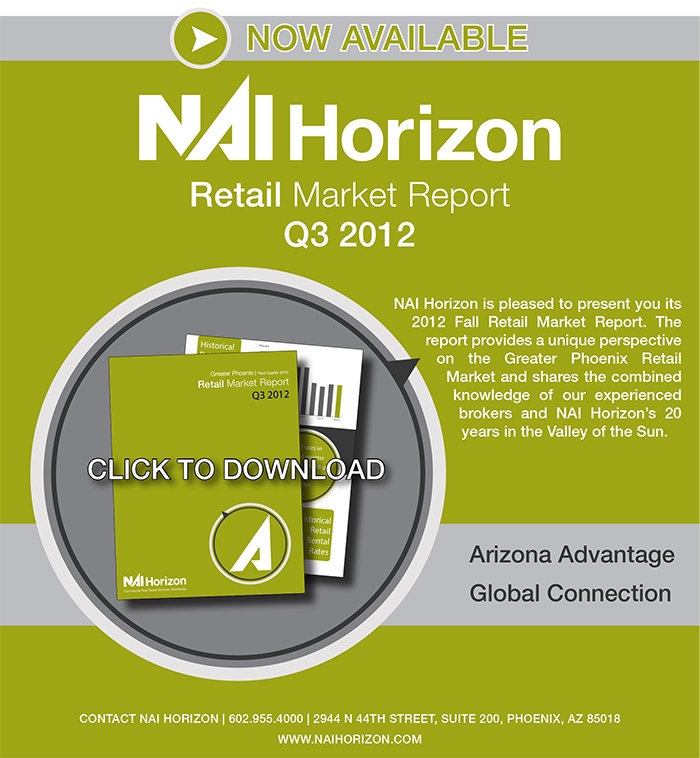Third quarter was a small hurdle for the retail market, as fluctuations saw absorption trend down and rental rates drop. Despite these contractions, construction employment is up and consumer confidence is growing, according to the Conference Board. Retail sales across the nation showed signs of growth, according to the Department of Commerce. There was a 1.2% advance in consumer demand in August; the growth was noticed in 12 of the 13 retail sectors. Furthermore, on a national scale the outlook for manufacturing job growth and the increase in expendable income should boost the demand for retail products and space alike. Retailers will need to continue to compete with the online market, which, according to Forrester Research, will bring an estimated $327 billion in sales throughout the US by 2016, by enhancing the shopping experience. For consumers, the act of shopping is now more about the social interaction and ambiance of a store or mall, rather than the product options that that cannot compete with an online resource.
Absorption for the third quarter retail market stands at 137,091 SF. This marks the third consecutive quarter that absorption has decreased for retail space. Metro Phoenix’s absorption level is down nearly 35% from the previous quarter. The Scottsdale submarket followed that trend by displaying a reversal from last quarter, as absorption was (43,444) SF compared to second quarter’s 210,000 SF. Third quarter’s best performing submarket was the East Valley, where space absorbed was recorded at 112,878 SF. The commercial real estate industry has noticed the impacts of efficient technology such as smart phones and tablet PCs, all encouraging a reduction in square footage and employees.
The top lease transactions during this quarter include the 34,162 SF community center lease signed by Planet Fitness at 7333 W Thomas Rd in Phoenix, the 28,000 SF community center lease signed by Goodwill at 1546 E Southern Ave in Tempe, and the 18,646 SF community center at 1346 W Southern Ave in Mesa signed by K-MOMO, an urban lifestyle clothing retailer. On average, rental rates continued to trend down, averaging at $14.49 for the third quarter.
The Phoenix retail vacancy rate found no room for movement, and posted the same level of 12.1% as the previous quarter. By submarket, the Phoenix Airport area had the best recorded change in vacancy, declining from 13.5% to 9.0%. The lowest vacancy rate was observed in the Northwest Valley submarket which includes Surprise, North Peoria, and Anthem at 8.4%. Historical vacancy and average rental rates are both trending down and converging. Nevertheless, as vacancy rates continue to decline, and approach the historical 7% level, landlords should find more room to cease concessions and raise rental rates. Occupancy percentages have trended up since third quarter of last year, posting a rate of 87.7%
Construction activity on retail properties dropped during the third quarter. Third quarter recorded 192,484 SF of space under construction. Delivered space declined to 94,940 SF, a 42% decrease, while construction starts fell 84% to 55,000 SF. In September of 2012, the Producer Price index for inputs to construction, a weighted average of the cost of all materials used in construction plus items consumed by contractors such as diesel fuel, increased .9% in both September and August. Even with the onset of heightened costs, throughout the past year the addition of construction jobs put Metro Phoenix at the top of “new construction jobs” list, according to Associated General Contractors. As noted last quarter, it will take a considerable amount of time, or a huge spark in consumer confidence, to overcome the indecisiveness and market fluctuations throughout the US.
Nationwide, retail properties valued over $2.5 million had a total sales volume of $9 billion for the third quarter, down from the previous quarter’s $12.1 billion. Also on a national scale, capitalization rates for retail properties had little to no movement, averaging 7.15%. In Phoenix, cap rates trended down to 7.96%, recording a 2.7% decline. Year to date leveraged buyouts of US retail companies realized a significant allocation of capital, standing at $7.66 billion. This level is up from the $4.45 billion recorded throughout 2011. Investors will look to high quality retailers who can weather a recession, and are still finding pricing discounts, according to National Real Estate Investor.

